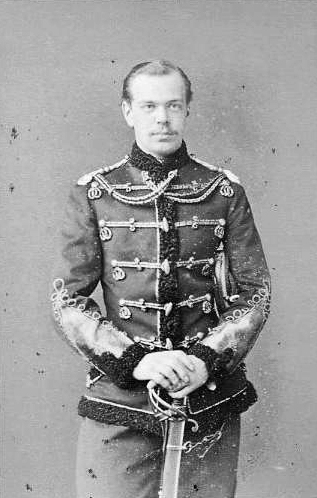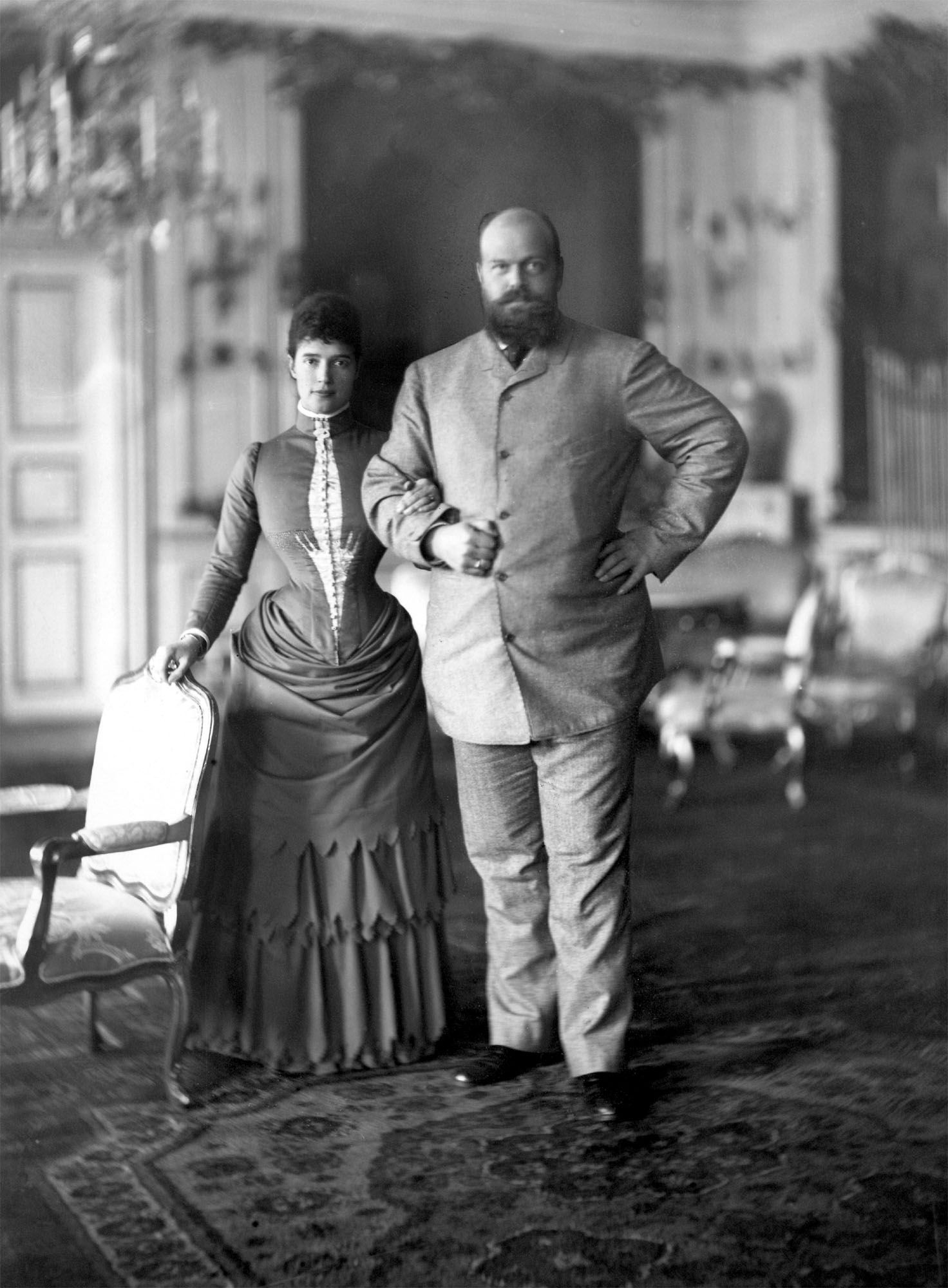by Susan Flantzer © Unofficial Royalty 2016

Alexander III, Emperor of All Russia; Credit – Wikipedia
The third child and second son of Alexander II, Emperor of All Russia and his first wife Marie of Hesse and by Rhine (Empress Maria Alexandrovna), Grand Duke Alexander Alexandrovich was born on March 10, 1845, at the Winter Palace in St. Petersburg, the capital of the Russian Empire. He had seven siblings:
- Grand Duchess Alexandra Alexandrovna (1842 – 1849), died of meningitis at the age of six
- Tsarevich Nicholas Alexandrovich (1843 – 1865), engaged to Dagmar of Denmark (the future wife of his brother Alexander III), died of meningitis at the age of 21
- Grand Duke Vladimir Alexandrovich (1847 – 1909), married Marie of Mecklenburg-Schwerin (Maria Pavlovna), had issue
- Grand Duke Alexei Alexandrovich (1850 – 1908), had illegitimate children via an affair with Alexandra Vasilievna Zhukovskaya
- Grand Duchess Maria Alexandrovna (1853 – 1920) married, Alfred, Duke of Edinburgh and Saxe-Coburg and Gotha, had issue
- Grand Duke Sergei Alexandrovich (1857 – 1905), married, Elisabeth of Hesse of Hesse and by Rhine (Elizabeth Feodorovna), no issue
- Grand Duke Paul Alexandrovich (1860 – 1919), married (1) Alexandra of Greece and Denmark (Alexandra Georgievna), had issue (2) Olga Karnovich, had issue
Since Alexander’s elder brother Nicholas Alexandrovich was the heir to the throne, Alexander received an education as befitted a Grand Duke and not a future Emperor. He had an abrupt and gruff personality and exhibited unusual physical strength. In the summer of 1864, Nicholas became engaged to Princess Dagmar of Denmark. She was the second daughter of King Christian IX of Denmark and Princess Louise of Hesse-Kassel and was a younger sister of Alexandra, Princess of Wales, wife of the heir to the British throne. However, events in early 1865 would change Alexander’s future. His brother Nicholas died from meningitis on April 24, 1865, at the age of 21. Alexander became the Tsesarevich of Russia, the heir to the Russian throne.

Alexander Alexandrovich, Tsarevich of Russia in 1865; Credit – Wikipedia
After his brother’s death, Alexander began to receive instruction in law and political science from Konstantin Pobedonostsev, a professor of civil law at Moscow State University. Pobedonostsev was very conservative and denounced democracy, trial by jury, and freedom of the press. He had a profound influence on Alexander for the remainder of his life. Tsesarevich Alexander’s political philosophy was the opposite of his liberal father, Alexander II. Emperor Alexander II was the most reforming emperor since Peter the Great. His foremost accomplishment was the emancipation of the serfs in 1861. In addition, Alexander II reorganized the judicial system, established local self-government called Zemstvo, instituted universal military service in which sons of the rich and the poor were required to serve, ended some of the privileges of the nobility, and promoted higher education in the universities.

Alexander Alexandrovich, Tsarevich of Russia and Princess Dagmar of Denmark engagement postcard; Credit – Wikipedia
In June 1866, while on a visit to Copenhagen, Denmark, Alexander proposed to his deceased brother’s fiancée, Princess Dagmar of Denmark, whose family nickname was Minnie. Minnie converted to Russian Orthodoxy and received the name Maria Feodorovna. Alexander and Minnie were married on November 9, 1866, in the Grand Church of the Winter Palace in St. Petersburg. After the wedding festivities, the newlyweds moved into the Anichkov Palace in St. Petersburg where they would live for the next 15 years. In addition, they spent time at their summer villa Livadia Palace in the Crimean Peninsula.

Wedding of Grand Duke Alexander Alexandrovich and Maria Feodorovna; Credit – Wikipedia
Alexander and Minnie had six children:
- Nicholas II, Emperor of All Russia (1868 – 1918), married Princess Alix of Hesse and by Rhine (Alexandra Feodorovna), had issue
- Grand Duke Alexander Alexandrovich (1869 – 1870), died young of meningitis
- Grand Duke George Alexandrovich (1871 – 1899), unmarried, died of tuberculosis, no issue
- Grand Duchess Xenia Alexandrovna (1875 – 1960), married Grand Duke Alexander Mikhailovich of Russia, had issue
- Grand Duke Michael Alexandrovich (1878 – 1918), married 1912, Natalya Sergeyevna Wulffert, had issue
- Grand Duchess Olga Alexandrovna (1882 – 1960), married (1) Peter Friedrich Georg, Duke of Oldenburg, no issue; (2) Nikolai Kulikovsky, had issue

Alexander, Minnie and their children in 1888, Credit – Wikipedia
On March 13, 1881, Alexander’s father, Alexander II, was assassinated in St. Petersburg, a victim of a bombing by the underground organization, Narodnaya Volya (People’s Will), and Alexander succeeded to the Russian throne. On the day of his assassination, Alexander II had signed a proclamation creating a consulting group to advise the Emperor, which some considered a step towards constitutional monarchy. The new emperor, Alexander III, canceled the new policy before it was published.
Early in his reign, Alexander III weakened the power of the local self-government his father had created called Zemstvo and instituted the “May Laws”, which restricted the professions and free movement of the Jewish minority and led to the severe persecution of Russian Jews. Alexander felt that his empire would have been permeated by anarchist troublemakers and revolutionary agitators and in 1881, he created the Okhrana, the secret police, and started to imprison political opponents in the Siberian labor camp. Another problem Alexander saw was a foreign infiltration of Russian society and he launched a radical policy of Russification. No major wars were fought during Alexander’s reign and he was nicknamed “The Peacemaker.” Certainly one of the most important accomplishments during the 13-year reign of Alexander III was the planning and the beginning of the construction of the Trans-Siberian Railway, the longest railway in the world.
On October 29, 1888, Alexander and his family were returning from a trip to the Caucasus via train when an accident occurred. The train derailed and plunged down a slope. When the roof of the dining car threatened to crush the passengers, including Imperial Family members, Alexander raised the roof with his shoulders and held it there until all were safely rescued. In the opinion of his doctors, Alexander’s super-human effort left permanent damage to his internal organs.

Emperor Alexander III and Empress Maria Feodorovna in 1893; Credit – Wikipedia
In 1894, Alexander became ill with nephritis, a kidney disorder. Alexander was on his way to the Greek isle of Corfu where he hoped to recuperate at Mon Repos, the villa of his wife’s sister-in-law, Queen Olga of Greece. However, when Alexander reached Crimea, he was too ill to continue traveling and stayed at Livadia Palace, his home in Crimea. It was soon obvious that Alexander would not survive and various relatives came to Crimea including Princess Alix of Hesse and by Rhine, the fiancée of Alexander’s eldest son Nicholas. Insisting on receiving Princess Alix in his full dress uniform, Alexander gave her his blessing on October 21, 1894. Thereafter, Alexander’s condition rapidly deteriorated and he died on November 1, 1894, at the age of 49. His son Nicholas became the last Emperor of Russia and married Princess Alix (Alexandra Feodorova) on November 26, 1894, just eight days after Alexander III was buried at the Peter and Paul Cathedral at the Fortress of Peter and Paul in St. Petersburg.

Alexander III’s death in Livadia by M.Zichy (Hermitage); Credit – Wikipedia
This article is the intellectual property of Unofficial Royalty and is NOT TO BE COPIED, EDITED, OR POSTED IN ANY FORM ON ANOTHER WEBSITE under any circumstances. It is permissible to use a link that directs to Unofficial Royalty.
Romanov Resources at Unofficial Royalty

